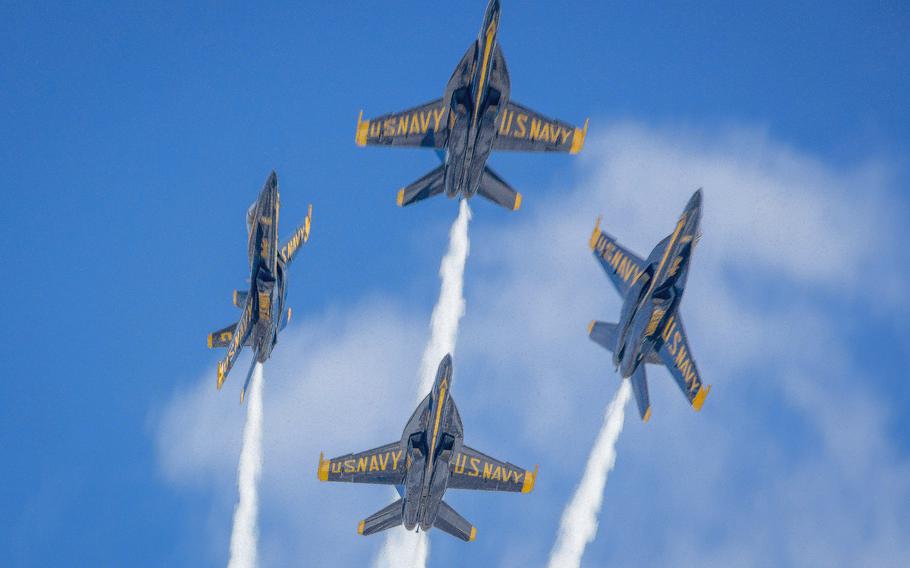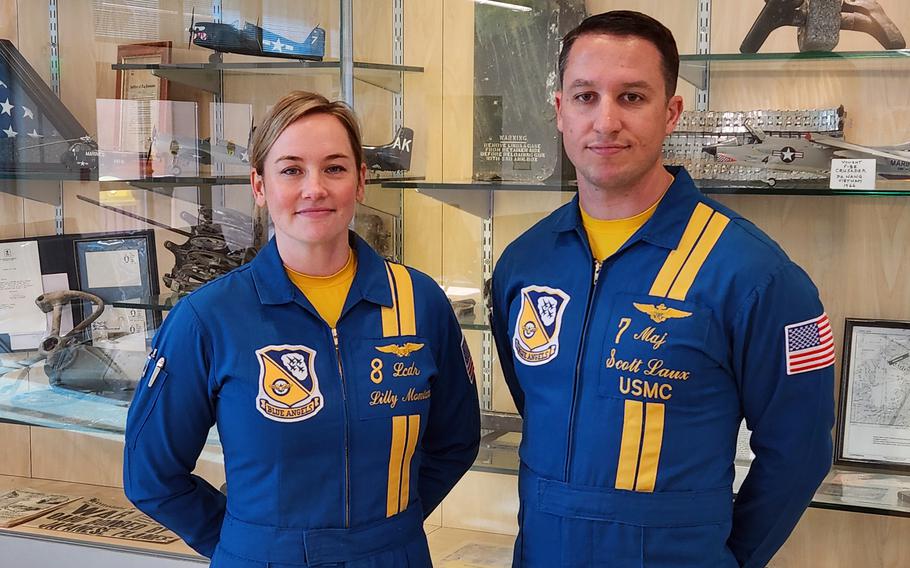
Blue Angels F/A-18 Super Hornets fly overhead during the Kaneohe Bay Air Show in Hawaii, Aug. 12, 2022. (Arianna Lindheimer/U.S. Marine Corps)
MARINE CORPS BASE HAWAII — Navy pilot Lt. Cmdr. Lilly Montana has a brief bit of advice for anyone planning to watch the Blue Angels flight demonstration team as it performs this August at Kaneohe Bay, Hawaii.
“There’s a couple surprises, one or two sneak passes,” Montana, a member of the team, told reporters Friday morning at Marine Corps Base Hawaii.
“I won’t spoil the surprise, but folks that come to K-Bay and come to the air show, bring your hearing protection,” she said.
Montana and fellow Blue Angels team member Marine Corps Maj. Scott Laux were in Hawaii this week to lay the groundwork for the squadron’s performance at the Kaneohe Bay Air Show Aug. 9-10.
The visit was also part of the team’s country-wide publicity blitz for the 32 air show demonstrations scheduled for 2025, kicking off March 15 with the Naval Air Facility El Centro Festival of Flight in California.
The team last performed at the Kaneohe Bay Air Show in 2022.
The stated mission of the Blue Angels, established in 1946 by Adm. Chester Nimitz, “is to showcase the teamwork and professionalism of the United States Navy and Marine Corps by inspiring a culture of excellence and service to country through flight demonstrations and community outreach.”

Navy Lt. Cmdr. Lilly Montana and Marine Corps Maj. Scott Laux, aviators with the Blue Angels demonstration flight team, pose at Marine Corps Air Station Kaneohe Bay, Jan. 10, 2025. (Wyatt Olson/Stars and Stripes)
Laux said that the Blue Angels team is “one of the most effective tools” the Defense Department has in executing that mission by performing at localities across the nation each year.
“Our aircraft are painted blue and gold, not gray,” he said. “We want to be seen. We want to be in the public’s eye. We want the public to know what the Navy and the Marine Corps are doing for the country.”
He pushed back on those who question whether funding the team – roughly $37 million a year – is worth the expense.
“[H]aving the ability to put members of the active-duty Navy, the Marine Corps, in front of the public to promote that culture of excellence and service to country, I would challenge anyone who asked that question to find a better resource than the Blue Angels to execute that mission,” he said.
“Obviously, we’re all the way out here in Hawaii right now,” he said. “We’ve got Key West on the schedule as well, so the exact opposite corner of the country. We’ve got Portsmouth, New Hampshire, other places in the South, the Midwest, the Northwest, the Southwest.”
There is also a human cost to performing precision aerial maneuvers, which at times bring the F/A-18 Super Hornet jets within 18 inches of each other and as low as 50 feet above the ground.
Twenty-six team members have died during practice or performance since 1946, a relatively large number given that there have been fewer than 300 demonstration pilots during that time.
The pair of pilots heads back to the West Coast on Saturday to continue visiting upcoming air show sites.
“Most places we go are excited to see us,” Laux said. “Air shows are exciting things so the energy is always high. And we’re excited to bring a pretty awesome product to each of these towns.”